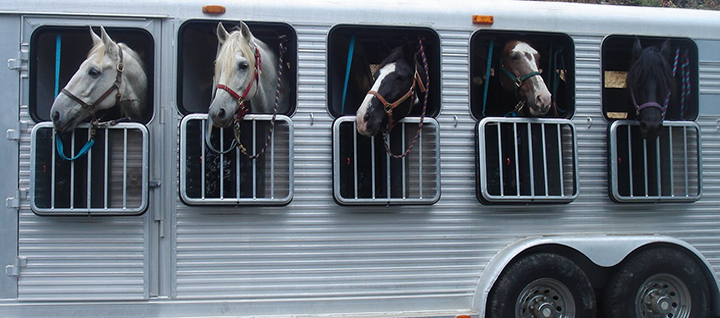Horse Transport

Transporting horses can be a challenging task, especially when long distances are involved. Since these animals require specific care, it is necessary to plan and prepare properly to ensure their safety and comfort during the journey. In this article, we will share some tips on horse transport, from choosing the right vehicle to preparing the animal and ensuring it arrives at its destination healthy and safe.
Horses can be transported by the usual means of transport, such as air, sea, river, rail, and the most common one: road transport.
In road transport, trailers are used for one or two animals, with a rear loading ramp and a front unloading ramp (unfortunately, few trailers have this feature). Trucks are also used, which can be either open or closed. The open ones are known as “cattle trucks.”
They have the major disadvantage of not protecting the horse against weather conditions and are not a safe means of transport for the animal. The closed trucks, also called “boxes,” provide better conditions since they are safe, protect the animal from bad weather, and offer some comfort. They are equipped with partitions padded with protective materials that help prevent injuries.
Precautions must be taken before and during loading, such as:
The horse should be given grain (feed, corn, oats, etc.) only up to two hours before loading. If this type of food is given too close to departure time, it may cause gastrointestinal problems. Just before and during transport, the animal should only be offered roughage, such as fresh grass, alfalfa hay, or grass hay. Horses travel more comfortably if they are eating. Provide water freely.
The more the horse’s body is protected, the lower the risk of injuries. The following areas should be protected:
Hoof coronet – with specific protectors, bell boots, or crepe bandages.
Legs – with special protectors made of foam or felt, covered with nylon or leather. The front leg protection should extend up to the knee and the hind leg protection up to the hock.
Poll – should be protected with an anatomical protector made of felt and leather. This prevents injuries from possible head bumps against the vehicle roof.
Tail – a tail guard prevents injuries from friction against the vehicle wall. Applying this protection requires skill and care. If applied incorrectly, it can cause serious harm: too tight, it may even cause gangrene; too loose, it may slip and injure the tail.
To minimize the effects of low temperatures and wind, the horse should wear a blanket, which must be lightweight to avoid overheating the animal.
Road transport of horses must include scheduled rest stops. The first should take place within the first half hour of travel, and the following stops should be every two hours, or sooner if needed. Each stop should last about 20 minutes.
For long-distance trips, stops should be scheduled every eight hours, with a five-hour rest period so the horses can drink water, walk for about 30 minutes, and, if possible, receive a shower.
Horses must not be transported without proper health documentation. A certificate for Equine Infectious Anemia (EIA) testing is mandatory. Certificates for Influenza, Glanders, and others may also be required. For example, in Argentina, additional tests are required for vesicular stomatitis, viral arteritis, and piroplasmosis. Along with these, the horse’s identification documents and the Animal Transport Permit (GTA) are also mandatory.
Few owners transport their horses with comfort and safety. We often see, especially in winter, horses being transported without protective blankets against cold and wind, and in poor conditions.



